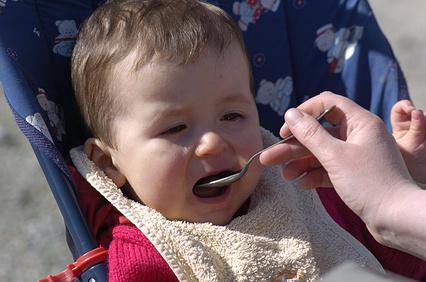When it’s time to start feeding your baby solids, you want to make sure he’s eating the healthiest foods available. This means plenty of fruits and vegetables. Commercial fruits and vegetables often have pesticides on them, so you may choose to go with organic foods instead. Talk to your doctor about which foods are most appropriate for your baby.
Why Make Organic Baby Food
Washing your fruits and vegetables doesn’t necessarily remove the pesticide residue left behind. When compared to her size, your baby is getting a higher percentage of pesticides than you would get as an adult eating the same foods. Organic companies produce foods using no pesticides, which you may feel to be safer for your baby. Though you can purchase small jars of organic baby food, making it at home allows you to save money and experiment with foods that you don’t always find in jars, like spinach or mango.
Tools for Making Organic Baby Food
You’ll need a pan to cook the food and a steaming rack can ensure that you aren’t losing any of the nutrients. A blender, food processor, stick blender or baby food mill will puree the foods, making them mushy for your baby. These items don’t always puree everything perfectly, so you’ll want to strain the foods with cheesecloth or a wire mesh strainer. Finally, you’ll need something to store the food in — ice cube trays help you freeze it for later.
How to Make Organic Baby Food
Choose the food you want to make and place it on the steaming rack inside the pan with a low level of water underneath. Cover and allow to steam for around 10 to 15 minutes. Test the food with a fork — you should be able to pierce it easily. Once you’ve steamed the food, you can puree it with a blender or food processor. Strain it to remove any large chunks, which could choke your baby. Soft fruits, like bananas and papayas, don’t require cooking. You should always feed your baby one food at a time to make sure she doesn’t have an allergic reaction. Once you’ve determined that she isn’t allergic, you can combine foods.
Storing Organic Baby Food
If you’ll be using it within a few days, you can keep the food in an air-tight plastic container in your refrigerator. Always use a clean spoon to remove the meal’s serving to avoid contamination. To keep for later, you can pour the puree into an ice cube tray. When it’s frozen, transfer to plastic bags or glass jars.
Which Foods to Choose
Sweet potatoes, squash, apples, bananas and peaches are popular choices for baby’s first foods, but you can choose any foods that you want. If you have a limited budget, you may not be able to purchase all organic foods, especially when they are not in season. Look for the list of the “dirty dozen” fruits and vegetables — the ones that contain the most pesticides. As of 2010, the worst fruits and vegetables are sweet bell peppers, apples, peaches, nectarines, celery, strawberries, imported grapes, cherries, pears, lettuce, spinach and potatoes. You should always buy the organic versions of these foods.





